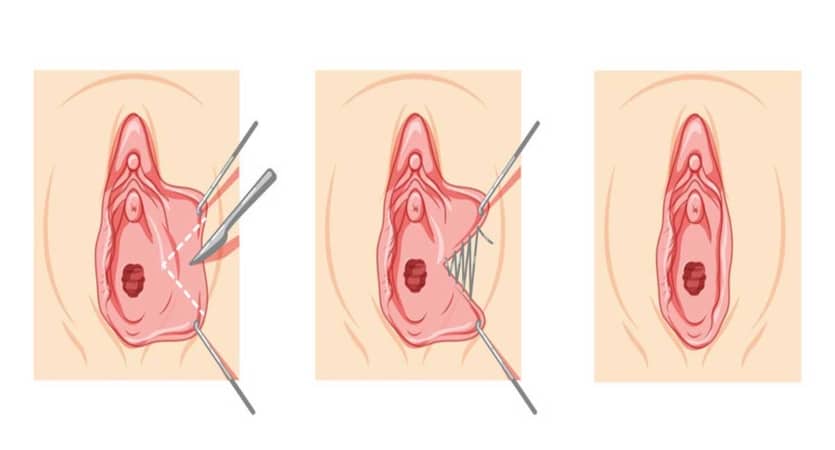Labiaplasty, commonly termed “vaginal rejuvenation,” is a surgery that modifies the labia minora, the inner vaginal lips. Its growing popularity stems from both aesthetic and functional motivations. Despite its benefits, it’s imperative to approach labiaplasty with caution and thorough understanding. Before opting for the procedure, individuals should familiarise themselves with its implications and potential risks and set realistic expectations. Consulting a qualified medical professional is crucial to making an informed decision.
Understanding the Procedure

Labiaplasty is a tailored surgical procedure whose approach differs based on individual needs and concerns. Many opt for it driven by cosmetic aspirations, aiming to enhance the appearance of their labia minora. Others pursue the surgery to alleviate physical discomfort or address functional challenges in daily activities. Performed under local or general anaesthesia, the surgeon removes excess tissue to achieve the desired shape and size.
The procedure typically lasts one to two hours. Before considering labiaplasty, one must introspect and discern one’s motivations. Gaining a comprehensive grasp of the surgery and setting clear expectations is pivotal in making an informed choice. To ensure optimal results and minimise complications, it’s imperative to choose an experienced and certified surgeon.
Reasons for Labiaplasty
There are several reasons why someone might consider this procedure:
Cosmetic Concerns
The aesthetics of one’s body can deeply influence self-perception and confidence. For some, the appearance of the labia becomes a focal point of insecurity. It may not align with societal or personal ideals, leading to diminished self-worth and challenges. Addressing these cosmetic concerns through labiaplasty can give individuals a renewed sense of self-assuredness.
Physical Discomfort
An enlarged or uneven labia can lead to various physical discomforts. Routine activities like cycling or running might result in friction, causing soreness or chafing. In intimate scenarios, this physical attribute can also translate to pain or reduced pleasure. Labiaplasty emerges as a solution to these challenges, relieving such discomforts. By undergoing this procedure, individuals can achieve a heightened sense of physical comfort, enhancing their overall quality of life.
Functional Concerns
Labiaplasty isn’t solely a matter of aesthetics or physical comfort; it’s also about functionality. For some, elongated or irregularly shaped labia can pose challenges in maintaining daily hygiene, potentially leading to frequent infections or discomfort. Additionally, certain urinary issues can arise, such as complications during urination or recurrent urinary tract infections. Opting for labiaplasty can effectively address and mitigate these concerns, enabling individuals to lead a healthier, more comfortable life.
Finding the Right Surgeon
Board Certification
When considering labiaplasty, selecting a board-certified surgeon is of paramount importance. Board certification in plastic surgery, or a closely related speciality, ensures the surgeon has undergone rigorous training and passed standardised exams. It not only validates their medical knowledge but also signifies adherence to ethical standards and ongoing education. At Aventus Aesthetics, our board-certified surgeon embodies a benchmark of expertise and trustworthiness.
Experience with Labiaplasty
Specialised procedures like labiaplasty demand a surgeon with a track record of experience. A seasoned surgeon, having performed numerous labiaplasties, brings refined skills, adeptness, and the ability to anticipate challenges. Their vast exposure equips them to craft natural-looking results aligned with a patient’s vision. It’s always prudent to prioritise a surgeon’s hands-on experience with labiaplasty to optimise outcomes.
Potential Risks and Complications

As with any surgical procedure, labiaplasty comes with its set of risks.
Scarring
One of the inherent aftereffects of any surgical procedure is scarring. In labiaplasty, while surgeons employ techniques designed to minimise visible scarring, scars will be completely unnoticeable. Depending on individual skin types, healing patterns, and post-operative care, some patients may find their scars more prominent than others. It’s essential to manage expectations and understand that while most scars fade and become less noticeable over time, the healing journey can vary from person to person.
Infection and Healing Issues
The post-operative phase plays a pivotal role in the outcome of the labiaplasty. Proper care can be the difference between smooth healing and complications. Infections, though uncommon with diligent aftercare, can occur if the surgical site isn’t kept clean or if post-surgery guidelines aren’t followed. Hence, it’s paramount to adhere to the surgeon’s aftercare instructions, attend all follow-up appointments, and promptly address any concerns to ensure optimal healing and results.
Recovery and Aftercare

Post-operative care is crucial for a smooth recovery.
Downtime
The recovery period following labiaplasty is a crucial phase that demands patience and adherence to prescribed rest. Typically, patients require approximately a week away from work to allow initial healing. Moreover, while light activities can resume after a few days, more strenuous physical exertions, especially those placing direct pressure on the surgical site, such as cycling or active exercise, should be postponed for up to six weeks. Each individual’s healing trajectory can vary, but it’s always wise to prioritise rest to ensure a smoother recovery.
Pain Management
Post-surgery discomfort is a natural consequence of labiaplasty. While the degree of pain can differ among individuals, it’s generally manageable. Surgeons typically prescribe pain medications tailored to the patient’s needs, ensuring relief during the critical initial days of recovery. Patients need to follow dosage recommendations and communicate any unexpected pain or concerns promptly. Remember, while discomfort is anticipated, there’s no need to suffer in silence; effective pain management is within reach.
Hygiene and Care
In the aftermath of labiaplasty, diligent attention to hygiene is non-negotiable. The surgical site, being a sensitive area, is susceptible to potential complications if not kept clean. Daily gentle cleansing, avoiding harsh chemicals, and wearing breathable cotton underwear can significantly aid the healing process. Adhering to the aftercare guidelines provided by the surgeon is essential. This not only wards off potential infections but also expedites the overall recovery journey.
Setting Realistic Expectations
Labiaplasty, while transformative, isn’t a magical solution. Approaching the procedure with informed and grounded expectations ensures satisfaction and reduces potential postoperative disappointments. Research, consultations, and a deep understanding of the desired outcome versus what the surgery can realistically offer are fundamental. By aligning hopes with achievable results, patients are better poised to appreciate the changes and benefits of the procedure.
Labiaplasty at Aventus Aesthetics with Dr Asma Ilyas

At Aventus Aesthetics, the labiaplasty procedure is epitomised by precision and care, primarily under the expert guidance of Dr. Asma Ilyas, our distinguished female cosmetic surgeon. Harnessing advanced surgical methods, Dr Asma Ilyas ensures that scarring is kept to an absolute minimum while prioritising exemplary outcomes. We also provide extensive post-operative care, ensuring our patients experience a smooth recovery.
Conclusion
As with all surgeries, understanding the procedure and thorough preparation is vital. Setting clear and realistic expectations can significantly impact the overall outcome. If labiaplasty is on your radar, ensure you are well-informed. When considering a labiaplasty, it’s paramount to seek advice from renowned clinics like Aventus Aesthetics. Consultation with a seasoned professional like Dr. Asma ensures you’re in capable hands, making the journey smoother and more assured.


